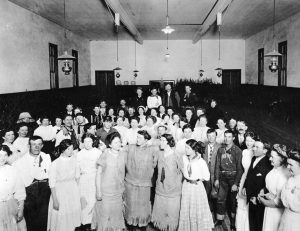 by Tonia Hurst, Kelley House Museum volunteer
by Tonia Hurst, Kelley House Museum volunteer
According to poet Alice Walker, “hard times require furious dancing,” though the traditional idea of a Hard Times Dance is something altogether different.
Similar to the Calico Balls of the mid-nineteenth century, which were started for debutantes and morphed into Civil War-era fundraisers for soldiers and wartime widows, a Hard Times Dance was part fun and part fundraiser. In lieu of expensive silks and satins, women wore dresses made of cheap cotton calico, the idea being that the money saved could instead be donated to exemplify ideals such as kindness and wartime austerity.
In some instances a Hard Times Dance was spurred by genuine need, as was indicated in the Salt Lake City Tribune in 1893: “An old timer suggested the other day that unless the financial question gets better soon the only parties that will be given will be ‘hard times dances’ which they used to give here in the old days, each girl bringing her own basket of lunch and the men bringing tallow candles, which were stuck in the wall of the log house where the dance was in progress.”
As economic times improved, the Hard Times Dance became more of a costume ball with its own peculiar traditions. Participants dressed in rags or costumes made from flour sacks or old curtains. They wore their “digging” clothes or work overalls and mismatched their shoes or they dressed as shabby gents or roadside beggars. Stiff financial penalties were meted out to those who wore fine clothing.
In 1912, the Circle Concordia club held a Hard Times Dance in Mendocino at the Odd Fellows Hall on Ukiah Street, which is currently the home of the Flockworks Gallery. A Mendocino Beacon reporter of the day noted, “most of the costumes worn by the gentlemen outclassed the ordinary hobo’s garb. Charley Zavits was generally conceded to have the best get-up of the men. The ladies cut out ‘glad rags’ and the costumes were of the roughest material obtainable. For fear of losing his scalp the writer refrains from mentioning the ‘homeliest’ costumes.”
Hard Times Dances achieved peak popularity between the Panic of 1893 and the Stock Market Crash of 1929. They give evidence of an emerging urban middle class with time and money to spare. As the trend progressed, the festivities took on what some would consider a mocking tone. Invitations were printed on brown wrapping paper and filled with deliberate misspellings, suggesting a lack of education.
In lean times, the Hard Times Dance took on a commiserating tone similar to this one from the Santa Cruz Evening News of 1932: “‘Old Man Depression’ is to be buried alive in a ‘Farewell to Hard Times’ Dance . . . after everyone has sufficiently recovered from their grief, a new era will be ushered in and a gayer spirit will prevail for ‘Miss Queen Prosperity’ will be given full sway. Several specialty numbers will be offered in expression of the coming era of better times.”
You can see this photograph at the Kelley House Museum — and others taken to record dances — during this final weekend of our exhibit, “Fun & Games: Mendocino at Play.” The museum is open Friday through Monday from 11 a.m. to 3 p.m.